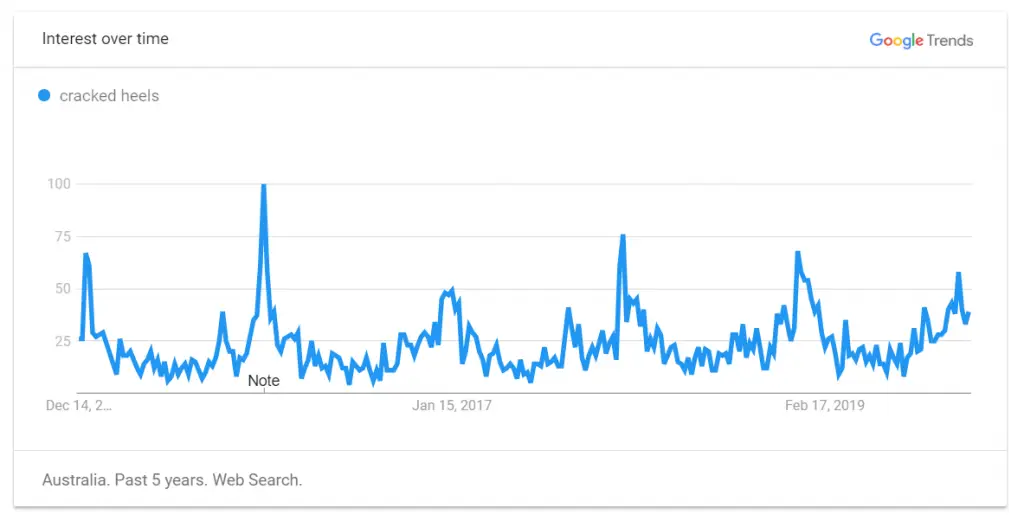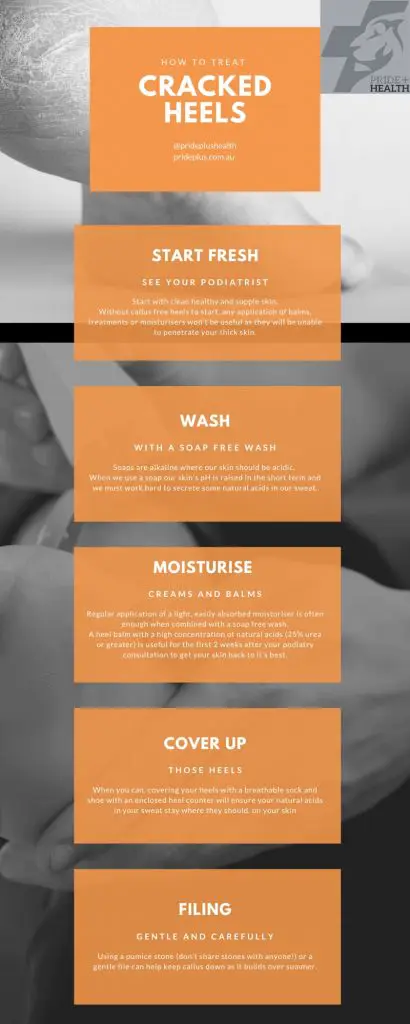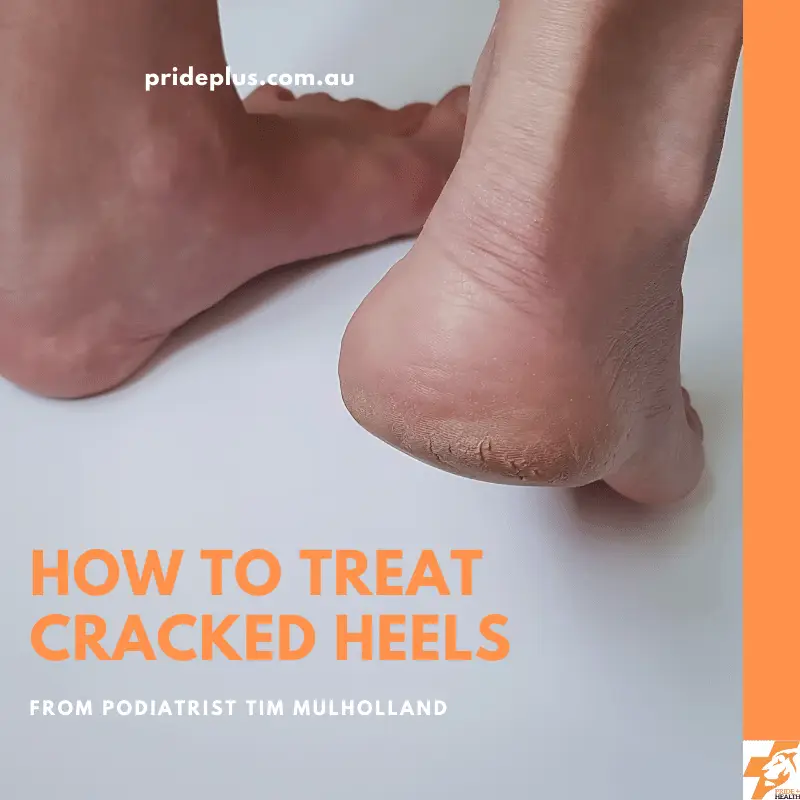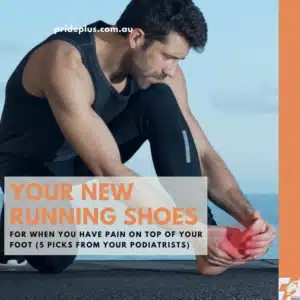For many Australian’s summer means cricket on the radio, splashing at the beach and the return of painful cracked heels. Just look at this chart – the spike in searches relating to cracked heels every summer is as regular as a prune juice drinker.

With summer here it’s the perfect time to answer some questions on cracked heels, also known as heel fissures.
What causes cracked heels?
Cracked heels are caused by the skin around the base of the heel drying out and eventually splitting. Your skin is your largest organ and it is constantly changing and repairing itself, adjusting to various conditions. When our skin is soft and supple it can be stretched and rubbed with no issues at all, crack and fissure free!
However when the skin dries out, just like a river bed in drought stricken central Australia our heels can crack and become a big problem. Infection can take hold in the cracks as it’s an ideal breeding ground for many different skin bacteria and fungi.
Complicating the issue, friction and pressure on dry skin will also lead to thickening of the epidermis, the outermost layer of skin. This leads to a callus forming which itself can become really dry and when the callus splits and cracks, can be very deep and painful.
So, the factors that contribute to cracked heels are:
- Dry skin
- Friction and pressure
Our skin dries out more as we age and with medical conditions such as diabetes. Certain decisions we make such as when we smoke cigarettes, drink alcohol to excess consistently, or walk around with our heels exposed will also lead to drier skin.
Friction and pressure on the skin comes down to how heavy we are. The more mass we move around, the greater the skin is pulled when we stand on our feet.
Now these are all factors! And this is a general article so there are plenty of very lightweight people who get cracked heels because of wearing thongs all summer. Some of these factors can be changed and some cannot.
To treat your cracked heels you need to address the factors that are most relevant to you. Finding these out can be as simple as running through a checklist with your podiatrist after you do the absolute most important thing first.
The Number 1 Most Important Treatment For Cracked Heels Is
Start with clean healthy and supple skin. If your heels are already dry and cracked for this you will need to see a podiatrist first. The podiatrist will prepare your heels for your at home remedy for dry cracked heels by debriding any callus and treating your fissures.
Without callus free heels to start, any application of balms, treatments or moisturisers won’t be useful as they will be unable to penetrate your thick skin.
To secure your appointment with our podiatrists you can book online here.
How To Treat Your Heels At Home (after heel preparation at your podiatrist)

Wash with a soap free wash
Soaps are alkaline where our skin should be acidic. When we use a soap our skin’s pH is raised in the short term and we must work hard to secrete some natural acids in our sweat. Making your skin work hard is not ideal after every shower so using a soap free wash means there is one less job for your skin to do and it can concentrate on being it’s soft and supple best.
Also, a soap free wash will reduce the risk of tinea pedis (athlete’s foot) due to fungal pathogens not enjoying an acidic environment. Win Win!
Examples include QV Wash, Alphakeri and Dermaveen
Moisturise
Regular application of a light, easily absorbed moisturiser is often enough when combined with a soap free wash. But beware! Not all moisturisers are created equal. Plain sorbolene is not ideal for heels and feet as it does not contain natural acids like urea and lactic acid that are essential for soft, supple skin.
A rescue remedy of a strong moisturiser like a heel balm with a high concentration of natural acids (25% urea or greater) is useful for the first 2 weeks after your podiatry consultation to get your skin back to it’s best.
Cover those heels
Yes it’s summer and you’re going to wear thongs and sandals. But when you can, covering your heels with a breathable sock and shoe with an enclosed heel counter will ensure your natural acids in your sweat stay where they should, on your skin.
For some a work around can be covering your heels at night with breathable cotton socks when you get into bed. If done just after moisturising your feet will have an entire sleep of moisture being absorbed into the skin.
Gentle home filing
Using a pumice stone (don’t share stones with anyone!) or a gentle file can help keep callus down as it builds over summer. This might prolong a visit to a podiatrist however you really can’t get through thick heel callus without risk of injury when doing it yourself.
What Helps Dry Heels?
With the treatment for cracked heels being so simple, there are a few other things you can do to help your cracked heels. These are the considerations we make every day with our activities, footwear and hosiery.
If you get cracked heels and you never wear shoes, starting to at certain times would be a great help for you cracked heels. This could be making sure you pop your shoes on instead of sandals or thongs if you know you’ll be walking a bit more, maybe inside in an air conditioned building, and saving the thongs for home or the beach.
If you wear only think nylon stockings, swapping to a think cotton sock could be just the change you need to make. Maybe this isn’t every day or for every outfit, but small changes made consistently can lead to big improvements in dry heels.
Are Cracked Heels a Sign of Diabetes?
You can have cracked heels without having diabetes, and you can have diabetes and not have cracked heels. But, having diabetes increases your chance of having cracked heels in 3 ways.
- Diabetes can reduce the amount of acid and sweat you can produce by your skin which leads to dry skin
- Diabetes can also lead to reduced circulation (have you had that tested yet this year?). If you circulation isn’t as good your skin will not be able to regenerate and grow as effectively. This can lead to drier skin and more fragile skin.
- With weight being a factor relating to cracked heels it needs to be recognised that people with diabetes have a higher change of being overweight as well. Any weight loss towards a healthy weight range will help your cracked heels.
Are Cracked Heels Dangerous?
They can be. Heel fissures can be breeding grounds for bacteria and fungi. In the immunocompromised an infected cracked heel can lead to significant health risks including sepsis and hospitalisation.
For people with very poor circulation a cracked heel could also lead to ulceration and amputation.
Fortunately these are two very rare but still real risks for many people who develop heel fissures.
Are Cracked Heels Fungus?
Having fungus in the form of tinea pedis on the skin can increase the risk of developing a cracked heel. Also, having a cracked heel can increase the risk of getting tinea pedis. You can absolutely have both or none.
Each week we see many people with tinea who do not have cracked heels, as well as those with cracked heels and no tinea.
Why Are Cracked Heels So Painful?
Our feet are one of the most sensitive areas in our body with more nerve endings than everywhere else except the gut. When we damage our feet from any injury (hello stubbed toe!) it can be incredibly painful as our nervous system is in attuned to picking up problems.
Cracked heels also hurt a lot because we are always on them! Compare this to a paper cut on your hand, a couple of times per day you would think “oh ouch that stings”, maybe after using hand sanitiser or cutting your citrus fruit. With a paper cut on the hand you can go hours not using that hand and forget about it.
Not so with cracked heels.
Every step on the ground, all 10,000+ of them will be a painful reminder to book in with your podiatrist and get those cracked heels treated!
Summary
Cracked heels hurt, can be treated easily and prevented in most cases.
There’s some simple things you can do yourself to manage your cracked heels and booking in with our podiatrists is a great way to start.
While you’re here. Do you get sore knees? Our physiotherapists have an online (telehealth) based program to treat knee pain from arthritis. Check it out.




